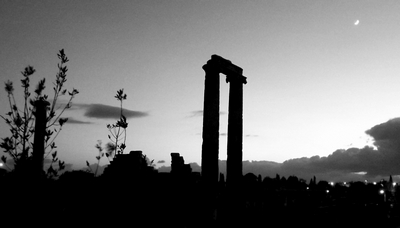Native archaeologists appear to possess a particular predilection in rebuilding ancient sites, writes Glenn Maffia. Probably at the behest of transient politicians whose belligerent insistence in procuring touristic revenues are in stark contrast to historical enquiry.
I have absolutely no qualms about visitors arriving in this historically wealthy land, the crossroads of a multitude of civilisations. What ‘sticks in my craw’ are the attempts at reconstructions of predominantly Graeco-Roman structures, in what appears a deceitful endeavour to remove imagination from our guests’ experiences.
We are increasingly presented with simplistic, ‘easy to digest’, reconstructed sites with an extensive use of ubiquitous concrete. Not the vastly superior Roman aggregate, but the inferior modern version.
I received a paper on an analyses of the chemical properties of Roman concrete, and the synthesised interaction of the components, from a friend and colleague within Europe recently. Upon reading this extensive paper, published in ‘Science Advances’ and entitled, ‘Hot mixing: Mechanistic insights in the durability of ancient Roman concrete’, I found its key points to be an inspiring revelation.
Magical Roman concrete
The strength and capabilities of Roman concrete have long been attested with the chemical analyses of identifying the inclusion of a volcanic ash within its constitutional composition. This ash is referred to as pozzolana, so named as it originates from the area of Pozzuoli in the Bay of Naples.
Though, in recent investigations researchers have identified yet another component: small white inclusions known as ‘lime clasts’, which are present in the aggregate of Roman concrete.
The natural elements, erosion, wind, rain, earthquakes, etc., create stresses upon all structures however well they are constructed. These stresses invariably produce cracks that pass through the lime clasts within the concrete undermining their efficiency.
However, when water, naturally rain, passes within these cracks it has the property of dissolving the lime clasts which produce a calcium-rich solution that recrystallizes into calcium carbonate, thus “effectively gluing the crack back together”.

When I observed the German Archaeological Institute (DAI) attending to some cracking of the topmost columns of Didyma’s Apollo Temple two years ago I happened upon a man heavy at work in the shaded nook beside the main stairway entrance. He was chipping and grounding away at a marble block.
I knew, of course, that marble when burnt produces lime, which is an important constituent of producing concrete. Therefore, I concluded the archaeologists were conducting an operation in harmony with ancient methods pioneered by Romans. Full credit to them if they were conducting what is known as ‘experimental archaeology’.
I do not know if lime clasts were included within this particular concrete mix, but I tend to believe that they would have been as I trust their professional veracity.
I believe that the DAI missed a great opportunity to engage with the public on this particular occasion, as I am sure a public demonstration of ancient concrete production would have been enthralling to those bothered to visit the Apollon site. Whatever their shortcomings, their work has always been uncompromisingly academic and professional.
3-D graphics
Of course the various Turkic tribes added their individual touch of colour to this historic landscape after the migrations from Central Asia. And great legendary stories they are.
But, and it is a big ‘but’, the present incumbents of this land are merely the latest people to lay claim. There are a multitude of other people, beliefs and philosophies that came before. It appears, therefore, that laying claim to artefacts prior to the Turkic tribes conquest means that your responsibilities include that of being caretakers, curators and custodians.
I have made a clarion call on numerous occasions of employing 3-D computer graphics to simulate original architectural structures without interfering with the remaining remnants of the authentic integrity. My colleagues whom are engaged in this field have produced inspiring results.
I visit many archaeological sites along the Aegean coast and feel that all may be greatly enhanced by such technology without altering the originals. While if the 3-D images are proved incorrect, then they can be easily adapted to incorporate any new discoveries. One cannot do that with ‘reconstructions’.
